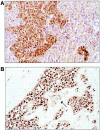Solid-pseudopapillary tumors of the pancreas are genetically distinct from pancreatic ductal adenocarcinomas and almost always harbor beta-catenin mutations
- PMID: 11943721
- PMCID: PMC1867216
- DOI: 10.1016/s0002-9440(10)62563-1
Solid-pseudopapillary tumors of the pancreas are genetically distinct from pancreatic ductal adenocarcinomas and almost always harbor beta-catenin mutations
Abstract
Solid-pseudopapillary tumors (SPTs) are unusual pancreatic neoplasms of low malignant potential that most frequently affect young women. Genetic events contributing to the development of SPTs are unknown. Whereas the more common ductal adenocarcinomas of the pancreas essentially never harbor beta-catenin or APC gene mutations, we have recently identified alterations of the APC/beta-catenin pathway in other nonductal pancreatic neoplasms including pancreatoblastomas and acinar cell carcinomas. We analyzed a series of 20 SPTs for somatic alterations of the APC/beta-catenin pathway using immunohistochemistry for beta-catenin protein accumulation, direct DNA sequencing of beta-catenin exon 3, and direct DNA sequencing of the mutation cluster region in exon 15 of the APC gene in those SPTs that did not harbor beta-catenin mutations. Immunohistochemical labeling for cyclin D1 was performed to evaluate the overexpression of this cell-cycle protein as one of the putative downstream effectors of beta-catenin dysregulation. In addition, we analyzed the SPTs for genetic alterations commonly found in pancreatic ductal adenocarcinomas, including mutations in the K-ras oncogene and p53 and DPC4 tumor suppressor genes, using direct DNA sequencing of K-ras and immunostaining for p53 and Dpc4. Almost all SPTs harbored alterations in the APC/beta-catenin pathway. Nuclear accumulation of beta-catenin protein was present in 95% (19 of 20), and activating beta-catenin oncogene mutations were identified in 90% (18 of 20) of the SPTs. Seventy-four percent (14 of 19) showed overexpression of cyclin D1, ranging from 10 to 70% of tumor nuclei. In contrast, no K-ras mutations were present in any of the 20 SPTs, and Dpc4 expression was intact in all 16 SPTs for which immunohistochemical labeling was successful. Overexpression of p53 was limited to only 3 of 19 (15.8%) SPTs. These results emphasize the two distinct, divergent genetic pathways of neoplastic progression in pancreatic ductal and nonductal neoplasms.
Figures




References
-
- Klimstra DS, Wenig BM, Heffess CS: Solid-pseudopapillary tumor of the pancreas: a typically cystic carcinoma of low malignant potential. Semin Diagn Pathol 2000, 17:66-80 - PubMed
-
- Mao C, Guvendi M, Domenico DR, Kim K, Thomford NR, Howard JM: Papillary cystic and solid tumors of the pancreas: a pancreatic embryonic tumor? Studies of three cases and cumulative review of the world’s literature. Surgery 1995, 118:821-828 - PubMed
-
- Horisawa M, Niinomi N, Sato T, Yokoi S, Oda K, Ichikawa M, Hayakawa S: Frantz’s tumor (solid and cystic tumor of the pancreas) with liver metastasis: successful treatment and long-term follow-up. J Pediatr Surg 1995, 30:724-726 - PubMed
-
- Rebhandl W, Felberbauer FX, Puig S, Paya K, Hochschorner S, Barlan M, Horcher E: Solid-pseudopapillary tumor of the pancreas (Frantz tumor) in children: report of four cases and review of the literature. J Surg Oncol 2001, 76:289-296 - PubMed
-
- Ogawa T, Isaji S, Okamura K, Noguchi T, Mizumoto R, Ishihara A: A case of radical resection for solid-cystic tumor of the pancreas with widespread metastases in the liver and greater omentum. Am J Gastroenterol 1993, 88:1436-1439 - PubMed
Publication types
MeSH terms
Substances
Grants and funding
LinkOut - more resources
Full Text Sources
Other Literature Sources
Medical
Research Materials
Miscellaneous

